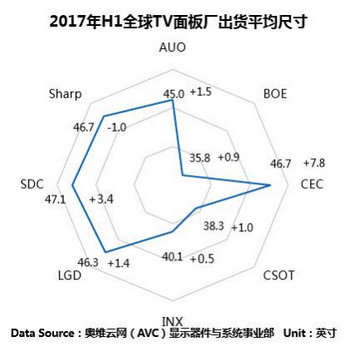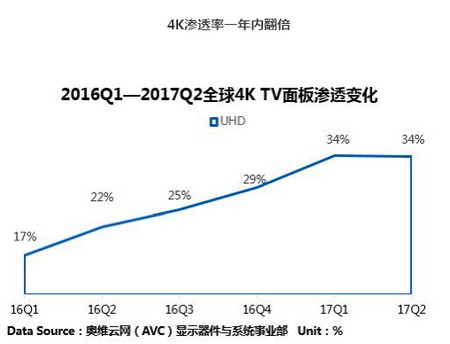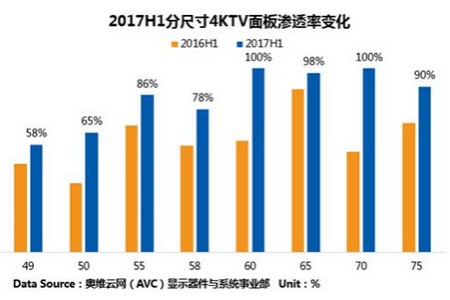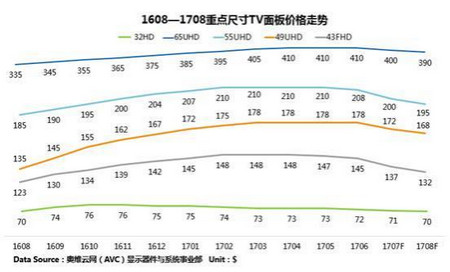The production capacity is increased, the shipment is reduced, 4K is doubled, supply and demand are reversed, TV panel prices are high, but it is obviously tired, the whole plant experienced the winter, but spring is close at hand, in 2017 Six months, what happened to the global TV panel market? The following will analyze one by one for you.
Low level shipments
In 2017 H1, global TV panels shipped a total of 122.8M, which fell 0.5% year-on-year, and the total shipping area was 64.8Mm2, an increase of 8.4% year-on-year. In 2016 H1, global TV panel shipments fell sharply due to the impact of earthquakes and technology. In H2 2016, with the gradual completion of new capacity ramp-ups at CEC, CSOT, BOE, and other panel makers, production capacity has increased. Although the factory was closed at the end of the year and Matsushita’s production capacity was transferred, the area of ​​H1 shipments increased by 8% year-on-year in 2017. .4% can see that the production capacity is still positive. The reason why shipments are still slightly reduced, the main factor is the global size of the TV panel due to the consumption of production capacity, Ovid cloud network (AVC) display device and system division data show that in 2017 H1 global TV panel shipments the average size It was 42.3 inches, an increase of 1.7 inches compared to the same period of last year. The increase in the partially consumed capacity was greater than the increase in production capacity, which caused the shipment volume to remain at the same level as last year's low level.

Sub-panel factory shipping situation to see:
LGD relied on huge production capacity support, and shipments remained generally stable. No matter whether it was in terms of shipments or shipments, LGD was the No. 1 supplier.
INX ranks second in terms of shipments, but from the perspective of its production size, the average size of shipments in the first half of the year is 40.1 inches, which is biased toward small and medium size.
BOE shipments ranked third, down 13% year-on-year, mainly due to the transfer of part of the production capacity of the B8 production line to NB, which resulted in a reduction in TV panel production capacity and ranked sixth in terms of shipments in the first half of the year.

Due to the closure of L7-1 production line by SDC, TV panel shipments decreased by 13% year-on-year, but due to its main production of small and midsize sizes such as 40-inch, this resulted in an increase in the average size of TV panel shipments after SDC's L7-1 plant closure. .4 inches, the average size of shipments in the first half of the year came to 47.1 inches, which was the highest for all panel makers, and the second-largest shipment area;
CSOT's production capacity in the T2 plant gradually climbed last year. Shipment volume of 17H1TV panels increased by 23% year-on-year, making it the largest panel maker with the largest increase in the number of shipments. However, due to the relatively high proportion of 32-inch panels, the average shipping size was only 38.3 inches.
Sharp boosted its 10th-generation line production and saw a significant increase in shipments, up 75% year-on-year. Sharp also shipped a large number of 60-inch and 70-inch large-size panels. Its average size also reached 46.7 inches.
Because CEC's 8.5-generation line capacity has been ramped up, shipments have increased by 76% year-on-year, and the production size has changed from 32-inch and 39-inch last year to mainly 39-inch, 55-inch and 65-inch. Shipment area increased by 161% year-on-year, a huge increase.

4K penetration doubles in a year
In the first quarter of 2016, the global 4K TV panel penetration rate was only 17%. After one year, the penetration rate had reached 34%, an increase of 17%, and the rate of increase was alarming.

In terms of size penetration, the penetration rates of 60-inch and 70-inch 4K are from 61% and 54% of 16-year H1 to 100% this year, and the 65-inch 4K penetration rate has also reached 98%. Overall, each size 4K penetration rates have risen in different ranges.
The price inflection point has come
In 2016 H1, the board price has fallen to freezing point. Following the Taiwan earthquake, Samsung technology and other issues, H1 global TV panel shipments fell 8.2% year-on-year in 2016, supply and demand reversed, and panel prices started long. Year-on-year increase, by 2017 H1, 32HD, 43FHD, 49UHD, 55UHD rose by 43%, 51%, 44%, 22%, respectively, such a huge increase makes all panel makers profit, and the whole factory is facing With huge cost pressures, it was necessary to adopt price increases to ensure profits, and the overall price increase of TV machines also seriously affected the sales volume in the terminal market. Under the background of declining sales volume, channel inventory gradually increased, which affected the shipment of the entire machine plant. According to data from AVC Display Devices and Systems Division, global shipments of H1 in 2017 decreased by 3.5% year-on-year, and shipments from the entire plant also caused factory inventory to rise, and each had to adjust. The volume of panel purchases has caused the global TV panel supply and demand ratio to reverse again.

The reversal of the supply-demand ratio also led to a loosening of the high-priced TV panels, especially in July, where the entire factory purchase volume was reduced. In order to negotiate prices with the panel makers, the prices will have a significant increase before the peak season. decline. Even if panel purchases rebounded in August/September, it is difficult to change the downward trend in panel prices before the end market has significantly improved, but the decline will slow down and the entire mill can purchase panels at a lower cost.
Constrained by the global market with poor shipments of TV panels, it is expected that in 2017 H2, TV panel prices will gradually take a downward trend, which will reduce the overall cost to a certain extent, indirectly activate the market, and panel purchases will also pick up. It is expected that the global supply and demand of TV panels will generally stabilize in the second half of the year.
55 Jack.China 4P4C RJ11 PCB Socket,Side Entry RJ11 Socket manufacturers, welcome RJ11 Jack Connector,2 Ports RJ11 Jack purchasers from worldwide to visit our site.
The RJ-45 interface can be used to connect the RJ-45 connector. It is suitable for the network constructed by twisted pair. This port is the most common port, which is generally provided by Ethernet hub. The number of hubs we usually talk about is the number of RJ-45 ports. The RJ-45 port of the hub can be directly connected to terminal devices such as computers and network printers, and can also be connected with other hub equipment and routers such as switches and hubs.
4P4C RJ11 PCB Socket,Side Entry RJ11 Socket,RJ11 Jack Connector,2 Ports RJ11 Jack
ShenZhen Antenk Electronics Co,Ltd , https://www.pcbsocket.com